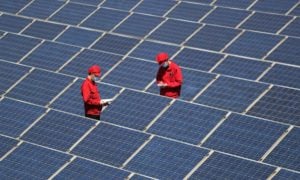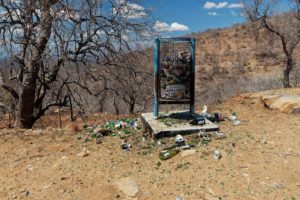Food systems contribute approximately one third of greenhouse gas emissions, and are therefore a crucial focus in global efforts to slow climate change.
Palm oil, the world’s most widely used vegetable oil, could play a key role in these efforts, with improvements in its production having potential to bring significant emissions reductions. Although palm oil production has faced intense scrutiny due to its connection with deforestation, recent developments indicate that progress has been made.
According to Trase, a commodity transparency initiative, palm-oil-related deforestation in Indonesia has been decreasing for almost 10 years, despite growth in production. Malaysia has experienced a similar trend. These two countries produce about 85% of the world’s palm oil.
The United Nations’ climate change convention has emphasised the importance of decoupling agricultural production from forest loss, stating that ending deforestation will be critical to achieving global net-zero emissions by 2050.
The Council of Palm Oil Producing Countries, an intergovernmental body led by Indonesia and Malaysia, asserts that the industry is on track to achieve net zero. Some industry experts even believe this goal can be reached by 2040, a decade before the UN’s target. However, it is essential to consider the necessary actions for palm oil producers, companies and countries, and examine the integrity of their commitments to meeting this challenge.
What is net zero and what does it mean for companies?
The Paris Agreement, adopted in 2015, aims to limit global warming to well below 2C above pre-industrial levels, while “pursuing efforts” to restrict the increase to 1.5C. In 2018, the UN’s climate science body, the IPCC, published a special report that emphasised the need for rapid transitions in various sectors to achieve the 1.5C target, including a 45% reduction in global net CO2 emissions by 2030 (from 2010 levels) and reaching net-zero emissions by 2050.
Using the IPCC definition, “net-zero” emissions refers to a balance between human-driven greenhouse gas emissions and removals over a specified period.
In the world of business, the Science Based Targets initiative (SBTi) was established in 2015 to help the private sector set emissions reduction targets based on scientific evidence. The initiative validates whether a company’s climate targets align with a 1.5C or 2C pathway, considers the year of net-zero commitment, and ensures robustness, credibility, and accountability in climate action.
Critics argue that “net-zero” targets can be misused if companies focus more on carbon removal and offsetting than on reducing emissions. To address this, frameworks like SBTi are crucial for companies to establish time-bound targets and demonstrate progress through transparent reporting and monitoring. Crucially, SBTi does not recognise carbon offsetting as emission reductions and requires separate reporting of offsets and removals.
What climate targets exist in the palm oil industry?
Pressure to confront sustainability challenges has driven efforts to produce and promote certified sustainable palm oil, and to eliminate deforestation and exploitation from supply chains. Managing the impacts of the Covid-19 pandemic and war in Ukraine has been a significant focus for the industry, but addressing climate change and emissions, especially those related to deforestation and peatland use, has also continued to grow in importance.
While the palm oil industry has been relatively slow to start working with SBTi on net-zero target setting, some major palm oil producers, including Malaysian firms Sime Darby and IOI Corporation, and Singapore-based Wilmar International, have made climate commitments. Though their targets have yet to be validated under the SBTi, many palm oil producers are experienced in working with sustainability frameworks that require them to disclose greenhouse gas emissions data.
Reporting emissions is a requirement for certification by the Roundtable on Sustainable Palm Oil (RSPO), the industry’s leading sustainability standard. The RSPO’s emission calculator, PalmGHG, has been used for over a decade to assess emissions related to land use, management practices and energy consumption.
Consumer goods manufacturers at the other end of the palm oil supply chain, including Unilever, Nestlé and Mars, have already adopted science-based net-zero and emissions-reduction targets. Many of these companies have recognised the importance of eliminating deforestation and land-use emissions to achieve climate targets. For example, Nestlé committed to become deforestation-free by the end of 2022 for palm oil and several other key commodities. It claims to now be 95.6% deforestation-free for palm oil and outlined that the final percentage points are hardest to reach due to the challenge of reaching smallholders. This is exactly why the cooperation and commitment of palm oil producers will be essential to realising such targets.
How are emissions accounted in the palm oil industry?
The Greenhouse Gas Protocol is widely used for accounting emissions. Developed by the World Resources Institute and the World Business Council for Sustainable Development, it helps companies build inventories of their emissions. It’s also a requirement for companies seeking recognition of their targets by the SBTi. The protocol categorises a company’s emissions into three scopes.
Scope 1 refers to direct emissions from company-owned and controlled sources, such as combustion in boilers, and vehicle emissions. Scope 2 covers indirect emissions from purchased energy consumed by the company. Scope 3 includes other indirect emissions throughout the value chain, including the extraction and production of purchased materials, transportation, and the use of sold products and services.
Under SBTi, if a company’s Scope 3 emissions are less than 40% of their total emissions, then they are only required to report their scope 1 and 2 emissions. However, for most business in most industries, Scope 3 accounts for over 70% of their carbon footprint.
Palm oil companies that operate both upstream (with plantations and mills) and downstream (with refining and oleochemical production) are considered “vertically integrated” in the supply chain. Their greenhouse gas emissions reporting for Scope 1 and 2 is often divided into upstream and downstream sections. But calculating and reporting on Scope 3 emissions is challenging due to supply chain complexities and a lack of traceability in the palm oil sector.
Scope 3 emissions require intensive supply chain risk management, engagement with suppliers and other stakeholders, and outreach efforts. While SBTi generally only requires targets to be set for Scope 3 when they account for 40% or more of a company’s total emissions, Scope 3 emissions in the palm oil industry are often excluded from greenhouse gas inventories due to difficulties collecting data.
| Scope 1 and 2 | Scope 3 | |
| Plantation | Land-use change will be the major source of emissions on the plantation, if any is taking place. This includes clearing or converting land from forests, as well as planting and replanting. If plantations are developed on peatland, the impact of land use change is even greater because methane and nitrous oxide are released from degrading peat soils. Fertiliser use and fuel for transportation are also major emissions sources. | Manufacturing and transport of fertilisers/agrochemicals Leased transportation |
| Mill | At the mill, the dominant source of emissions is methane from palm oil mill effluent. This is an oily wastewater generated when mills process oil palm fruit into crude palm oil, and is usually held in treatment ponds to prevent discharge into groundwater. Other emissions come from steam boilers, fuel consumption and any purchased energy. | Embedded emissions in purchased fresh fruit bunches, transportation, leased storage, etc |
| Refinery, crusher & oleochemical plant | At the plant, emissions primarily come from fuel and energy use. | Transportation, international shipping, purchase of palm oil/palm kernel and their processed products |
The industry faces significant traceability challenges due to the involvement of so many independent mills, dealers, and millions of smallholder farmers. Currently, not a single palm oil producer has published Scope 3 emissions in their greenhouse gas inventories, although some have begun mapping them.
For RSPO member companies, the PalmGHG calculator helps companies track emissions related to land-use change, peatland management, fertiliser, palm oil mill effluent, and more. It also includes calculations for carbon sequestered from any forests conserved within a concession and from the oil palms themselves. It calculates net greenhouse gas emissions by subtracting sequestered carbon from emitted carbon.
These efforts seem to have had an impact, with RSPO-certified palm oil found to generate about 35% less emissions than non-certified palm oil per kilogram of processed oil. The difference is attributed to factors such as peatland use (RSPO members are less likely to plant on peat), crop yields (they tend to have higher yields) and treatment of palm oil mill effluent (they are ahead on methane capture technology).
SBTi’s Forest, Land and Agriculture (FLAG) initiative and the Greenhouse Gas Protocol’s upcoming guidance on the land sector and GHG removals will provide additional frameworks for land-intensive sectors to account for emissions, carbon removal and storage. These initiatives are expected to complement the RSPO’s emissions calculator, enabling companies to estimate their net emissions, set science-based targets and work towards net zero.
How can palm oil emissions be reduced?
Several strategies can help reduce emissions in the industry. Firstly, preventing plantation development on tropical peatlands and upholding no-deforestation commitments. Implementing peatland management systems can also prevent fires and further emissions on existing peatland plantations. Preserving primary and secondary forests – those regenerating largely through natural processes – within oil palm concessions is important, as these forests store more carbon than plantations.
Carbon stock value of lands in RSPO’s PalmGHG
| Land uses | Carbon stock (tonnes of carbon per hectare) |
| Primary forest | 225 |
| Logged forest | 87 |
| Coconut | 75 |
| Rubber | 62 |
| Cocoa under shade | 70 |
| Oil palm | ≥50 |
| Secondary regrowth | 48 |
| Shrub | 26 |
| Food crops | 9 |
| Grassland | 5 |
Addressing palm oil mill effluent is another key area. Treating it using anaerobic digestion simultaneously captures and utilises methane, whilst providing an economic return through the generation of biogas. This practice is becoming more widespread among plantation companies, helping to reduce emissions and generate energy.
Managing fertiliser use is another essential for mitigating emissions. Chemical fertilisers, which emit nitrous oxide, a particularly potent greenhouse gas, must be carefully managed. Organic residues, such as palm fronds and empty fruit bunches, can be utilised as alternatives with lower carbon footprints.
Transitioning to renewable energy sources, such as solar power and biomass waste, to power production processes can reduce emissions from energy consumption in both upstream and downstream operations. Optimising energy efficiency and increasing production efficiency at mills and refineries can further reduce emissions per unit of production.
How can palm oil producers remove carbon from the atmosphere?
Living plants, through photosynthesis, capture CO2 from the atmosphere and store it in their tissues, including their leaves, stems and roots. This carbon can also be transferred to the soil through plant roots or plant material. To meet the goals of the Paris Agreement and achieve net-zero emissions will require significant removal of atmospheric carbon. Therefore, nature-based solutions, like forest restoration, improved forest management, agroforestry and soil rehabilitation, will be essential.
However, carbon offsetting, which involves payment for carbon removals elsewhere, has drawn criticism for potentially undermining emissions reduction efforts and lacking transparency. Crucial to ensuring integrity will be frameworks like SBTi, which emphasise the need for clear and transparent communication on carbon removal and offsetting to avoid greenwashing and false accounting.
In the palm oil industry, atmospheric carbon removal is primarily accounted for by the growth of oil palm crops and by forest conservation within concession areas. The RSPO’s PalmGHG calculator considers these factors when calculating net emissions.
Under the Greenhouse Gas Protocol and SBTi, carbon removal accounting becomes more complex, requiring separate reporting of emissions and removals, with a focus on removals on land owned or operated by a company rather than through purchased offsets. The upcoming guidance from the protocol will provide further clarity on carbon removal calculations in the land sector, offering opportunities for the industry to progress towards net zero.
What about palm oil’s indirect emissions?
Scope 3 emissions encompass all the indirect emissions throughout a supply chain, including raw material production, logistics, distribution, manufacturing, retail, product use and end-of-life. Reducing Scope 3 requires collaboration among different companies in the supply chain. While it presents significant challenges for emissions accounting, it also presents opportunities for cooperation. Working with suppliers, including independent mills, dealers and smallholders, will be key. However, without traceability, it’s difficult to ensure compliance with sustainability policies, let alone to measure emissions and implement reduction measures. Collaboration, investment outreach, engagement and incentives, such as preferential sourcing and fair prices, will be essential for progress.
One area which may offer solutions around Scope 3 is regenerative agriculture. Though it remains relatively new to the palm sector, practices such as intercropping and cover cropping, mulching and biochar application can enhance soil health, increase biodiversity and lock carbon into the soil. These methods can reduce reliance on emissions intensive chemical fertilisers and improve yields.
While implementing regenerative practices into massive commercial plantations may pose challenges, it holds significant potential for smallholder farmers, of which there are an estimated 7 million across the global palm oil industry. These small-scale farmers can benefit from diversified income streams, and make savings due to reduced fertiliser use, as well as potential income from the carbon market.
Dr Reza Azmi, executive director of Malaysian social enterprise Wild Asia, emphasises the importance of collaboration between commercial actors and smallholders to scale up regenerative practices, maximise the climate and biodiversity benefits of oil palm, and improve traceability through investment and incentives. He stresses that there are significant opportunities for the industry and its supply chains to support smallholders in adopting sustainable farming practices.
Reaching net zero
The road to net-zero palm oil will require hard work and cooperation, particularly in five action areas.
⚪ First, zero deforestation, meaning upholding no deforestation commitments and policies, including support for forest protection, and restoring degraded lands.
⚪ Second, adopting sustainable land management practices, such as responsible planning, agroforestry, and reducing fertiliser use.
⚪ Third, capturing and using methane from palm oil mill effluent.
⚪ Fourth, adopting renewables, including biomass waste and solar power.
⚪ Fifth, carbon removals, via nature-based solutions and set-aside conservation areas.
The palm oil industry has already demonstrated action to reduce deforestation. But to reach its net-zero goals, it will need to build collaboration across the supply chain, as well as with governments, civil society and consumers. Vitally, it will require significant engagement with its suppliers, including independent mills, dealers and smallholders, which will be key to addressing and reducing Scope 3 emissions.















